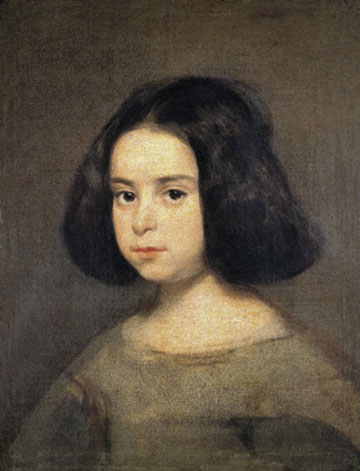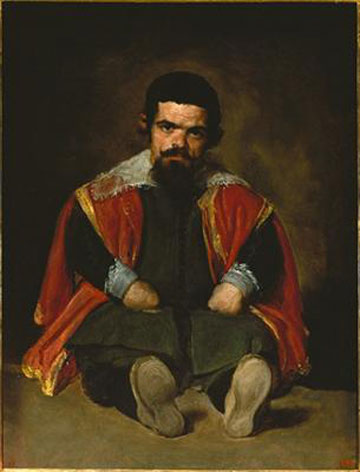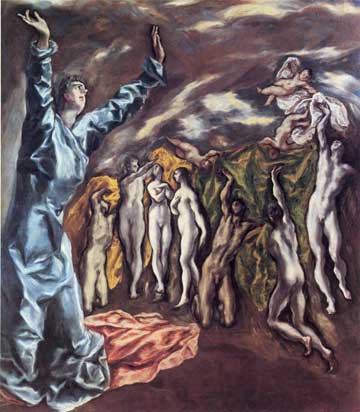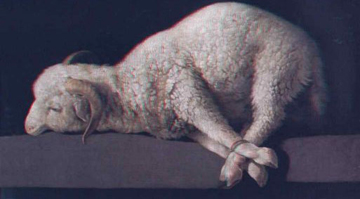"Spanish Painting From El Greco To Picasso: Time, Truth and History"
Juan Seoane Cabral
From the display of the exhibition two different means of appreciation are experienced: one is the strategy in which the show was curated collaborative by Carmen Gimnez, and former director of Prado Museum Francisco Calvo Serraller. The second is a survey of Spanish painting during the self-absorbed years of the 1600's, when the Counter-Reformation by the Catholic Church was already solidified in the mind and soul of artists.
Unlike many other exhibitions, this one is not organized chronologically but in terms of subject matter relevant to Spanish painting's history: Monks, Bodegones, Weeping Women, Virgins and Mothers, Nudes, Childhood and Monsters, Knights and Ghosts, Angels and Crucifixions. One after the other, all of these themes is subdued to the outcome of Catholicism in its Spanish interpretation. In the exhibition there is also an account about the lessening of Counter-Reformation's rigid canon. As the viewer advances, it enters as well into a dimension where it visually engages from painting to painting with the confrontation of the ideals of Puritanism and iron discipline that was imposed on Spanish Catholics and was so well reflected by Francisco de Zurbarán's "Saint Huge in the Refectory". This image is an example of that age of cloistered practices and grounded spirituality. In this painting there is no light source; either it's the self-sufficient expressiveness of the brushwork, or an allegorical (exogenous) relation to the image. There's only the Saint, holding a skull and gazing at it as into a reflection on a mirror. The colors are earthy; the feeling of the painting is somber and dry. Sadness and loneliness are felt from the first impression. Yet, at a second viewing the painting becomes a commendable motif for the church's member. It is essential to remember that the Counter-Reformation was a momentary solution that the Catholic Church found to re-assure the medieval doctrines of Catholicism in views of the increasing danger of the more liberal Protestantism.
After these markedly ecclesiastical subjects, there is a display of Bodegones. Performed with asceticism these still-lifes are more reminiscent of the self-flagellating saints and martyrs from the middle-ages than of the luscious tone that this genre will acquire in the works of Dutch painters from the same period.
It's not until after the section of Weeping Women and Virgins, with its implicit praise of the domestic world as a natural environment for inert women, that the curators of the exhibition made a tactical decision that divides the exhibition in two parts: The first one goes from Monks to Motherhood, the second one, from Childhood to Crucifixions. There is a clear opposition, yet complementation between the two sections. While Monks and Motherhood stand for discipline and keenness, Childhood and Crucifixion do the same for confusion and submission. At this point the exhibition can be considered as a description of the transit that Spanish artists made from the restrictive religious imagery to the liberations of the creative power and libido.
"Christ in Limbo" by Alonso Cano, an explicit and daring male nude, personifies the figure of Christ in heaven. It's conspicuous that in this painting the artist shows the Christ naked, however taking the figure out of this world, to a location of celestial existence. Is it also an accident that the only Twentieth Century nudes that we find in the exhibition belong to two well known misogynists like Salvador Dalí and Pablo Picasso? The tedious "Dreams caused by the flight of a bee around a Pomegranate, one second before awakening" (1944) and the sodomized female figure from "Nude on a red chair"(January 21, 1939), tells us something beyond the intention of these two artists, as there is little room for interpretation after witnessing a female nude attacked by two tigers and another one deconstructed, this time not in terms of Cubism and points of view, but in relation to a plagued relation with this subject represented. Although a constant in Picasso's career, finishing the painting in one sitting can be taken, in the context of this exhibition as a sign of detachment from feminine sexuality.

Velásquez: Portrait of a Girl
Velázquez's "Portrait of a Girl" is a paradigm of the way artists were meant to depict childhood, which until then was considered somehow monstrous because of their proximity to a rudimentary state of civility and thus, too close to the Original Sin. All the images of children are centered in the canvases, harmonious in spacing and composition and lacking in strong colors or contrasts.

Velásquez: Don Sebastian de Mora
Also by Velázquez, "Don Sebastian de Mora" (1643-44) introduces into Spanish art a theme that would be vastly used, the Monster, especially so for its flexibility and adaptability to the social descriptions of historical events, as we'll find in Goya's "Horrors of War" series. In this milieu, it's difficult to include one of the most Venetian-like paintings by El Greco, "The Vision of Saint John" (1608-14). It seems somehow pushed into the walls of the Museum. Its perspective space, its Mannerism and inveterate Baroque emotion, as the orchestration of colors, makes this work distinctive.

El Greco: The Vision of Saint John
Click on image to see larger view
In the last room of the exhibition we truthfully reach a pinnacle. As the precedent sections in the Guggenheim Museum were about the tormented spirit of an age and its several calls to order, this last one is about the acceptance of mankind's intrinsic weakness and its necessity for a linkage to a world of superior dogmas and static truths. "The Liberation of Saint Peter"( 1657-59) by Juan de Váldez Leal, shows one of the only display of warm colors, as the Angel helps Saint Peter to escape from his captors and from the uncertainty of his incarceration.
If at some point during our tour throughout the exhibition it seemed that we were witnessing the liberation of Counter-Reformation's dogma and its tensions, now we are surprisingly facing "Christ Crucified" (1643) by José de Ribera as the last painting of the show. Whether this crucifixion confirms the dictums of the Medieval Spanish Catholicism in its reluctance to accept any tangent path towards the completion of the self by other means than the practice of the Catholic truisms; or this recall of Christ in the cross remarks the solitude and hardship that any man of faith faces in this world, it stays open in its answer.
Each age has its own leading ideas, and painting, as carrier of mechanisms of perception, remain as the most truthful and tacit inheritance. An art work that helped the Catholic Church in the Seventeenth Century to represent ideas about religion helps now at the Guggenheim Museum to evoke and portray the enactments of those doctrines.
Evenly understood in its rendering of the spirit of a peculiar Age, as it is comprehensive of the psychological frame of it, the exhibition allows a backward glance as we reach the front door on our way out; "Agnus Dei" by Francisco de Zurbarán, reminds us of the sacrificial and compassionate sentiment that was involved in the acts of those Spanish artists.

Francisco de Zurbaran: The Bound Lamb Agnus Dei Anaglyph
Click on image to see larger view
 back to Contents page
back to Contents page